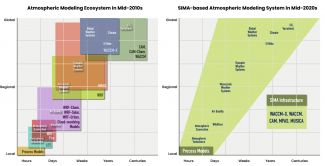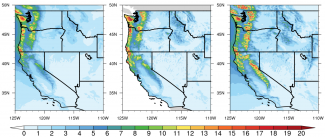The System for Integrated Modeling of the Atmosphere (SIMA) project aims to unify existing NCAR community atmosphere modeling efforts across weather, climate, chemistry, and geospace research. NCAR scientists, in partnership with the atmospheric and geospace sciences research community, are developing a SIMA framework and infrastructure that enables simulations of atmospheric processes and atmospheric interactions with other components of the coupled Earth system ranging from the surface to the ionosphere, and across scales from cloud-resolving weather to decadal climate studies. One of SIMA’s goals is to enhance atmospheric and earth-system modeling applications for frontier-science problems. An example is the sub-seasonal to seasonal predictability of tropical cyclone formation, which requires the capability to represent convective-permitting scales over the tropics coupled to an Earth System Model (ESM). This can extend to investigating the role of aerosols on tropical cyclone formation. Another frontier-science application is quantifying the impact of biomass burning on air quality, atmospheric chemistry, and weather from local to global scales. This requires the capability to represent fires on convective-permitting scales and detailed chemistry and aerosol processes. Additional frontier science application examples are described in the SIMA Vision document.
SIMA will allow NCAR to shift from using a complex modeling ecosystem composed of several atmosphere models, each with their own specific application (e.g., Weather Research and Forecasting (WRF) and Model for Prediction Across Scales (MPAS) standalone atmosphere models for weather research, Community Atmosphere Model (CAM) for climate research, Whole Atmosphere Community Climate Model eXtension (WACCM-X) for thermosphere and ionosphere research) into a single modeling system that can be configured for a range of applications (Figure 1). In November 2021, SIMA version 1 was released to the community. This initial version of SIMA includes development of a CAM configuration that contains regionally-refined grids over the Arctic and Greenland and development of high-resolution capability of WACCM-X and one-way coupling between WACCM-X and a geomagnetic grid mesh for magnetohydrodynamics calculations. For SIMA v1, atmospheric chemistry input, emissions data, and chemistry code have been modified to be compatible with unstructured grid meshes and regional refinement of grids. Atmospheric chemistry simulation output for a CAM configuration with regional refinement over the contiguous US was made available via the Geoscience Data Exchange site. A model-independent chemistry module, which enhances the flexibility of prescribing the chemical constituents and reactions, was released in a box model configuration for testing and classroom teaching.
When SIMA is mature, it will provide functionality for interoperable model components, including physics and chemistry schemes, as well as dynamical cores, by using the Community Common Physics Package (CCPP) in its functionality. A suite of physics parameterizations from WRF and CAM are being modified to be CCPP compliant and thus, will become available as part of SIMA. Recently, software engineers and scientists at NCAR, the DTC, and NOAA held a series of discussions about the usefulness of CCPP for the physics suite in CAM as well as any future SIMA needs that CCPP does not yet address. In summary, the CCPP should improve the efficiency of future CAM code development and maintenance, which will enable other modeling system advancements. CCPP is easy to build upon, is explicit, and its implementation facilitates the detection of bugs and inconsistencies. At the same time, it is understood that the CCPP framework will not do everything needed or desired for the modeling system, and additional steps will need to be taken to achieve specific requirements.
One major achievement in developing SIMA is implementing the MPAS dynamical core in CAM giving CAM new functionality to resolve convective motions with a non-hydrostatic dynamical core. Several tests are being conducted using a global MPAS mesh at 60-km grid spacing with regional-refinement to 3-km grid spacing over a specified region. An example application from the NSF-funded EarthWorks project demonstrates the capability of predicting precipitation amounts over the Pacific Northwest region of the US (Figure 2).
| Wet-season (November-March) average precipitation rate (mm/day) over the western U.S. for 1999-2004. Left panel shows results from CESM-MPAS at 3-km grid spacing, middle panel observations from PRISM on a 4-km grid, and right panel results from WRF at 4-km grid spacing. CESM-MPAS has a small underestimation compared to the observations, while WRF tends to overestimate precipitation rate. The probability distributions of daily precipitation show that CESM-MPAS captures the PDF better than WRF, especially for more extreme precipitation. From X. Huang et al. (2022) in Geosci. Mod. Dev. |
During the past year, the SIMA governance structure has been broadened to establish a SIMA steering committee, a SIMA Project Lead, a SIMA Scientific and Technical Co-Leads group, and a SIMA external advisory panel. Under this expanded structure, SIMA is taking a two-pronged approach to continued infrastructure development. The first is continuing to produce capabilities already identified as important. For example, there is planned work for enabling simulations with the SIMA-provided configuration of using the non-hydrostatic MPAS dynamical core in CAM using a global grid spacing of 3.75-km, which would provide the ability to perform subseasonal to seasonal forecasts in an Earth System Model. Other high-priority targets include refactoring CAM physics to be compliant with CCPP; developing an online, flexible regridding tool to improve input preprocessing for desired model grids; and enhancing the Model Independent Chemistry Module, while implementing it into CAM.
Another path for SIMA development is to identify and pursue a frontier-science application that will guide infrastructure development. NCAR has asked their staff to propose projects that require SIMA to develop additional functionality that can be utilized in investigations that will understand processes or predictability from local to regional to global scales and synthesize cross-disciplinary science. The SIMA developments for this science application should open the door for many other groups to apply SIMA for advancing their own science interests.
SIMA leadership is looking forward to deeper engagement with the community to further advance the single atmospheric modeling system and conduct exciting, new science. See more information about SIMA at sima.ucar.edu.

